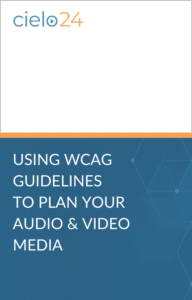Using audio description in the classroom comes with many advantages. Audio description, by definition, is…

6 Benefits of Audio Description for All Audiences
Have you ever been in a room when everyone else is laughing, but you don’t get the joke? This experience is something that those with blindness or visual impairments experience daily during their video consumption. Traditional TV or movie viewing does not accommodate those who can’t see what is happening on screen. This is where the audio description comes in.
Audio description is an important accessibility resource for those with blindness or visual impairments, as it allows these groups to fully experience movies, TV shows, YouTube videos, and other visual content by describing the visual elements playing out on screen. A National Health Interview Survey conducted in 2018 reveals that over 32.2 million Americans, a little less than 10% of the population, above the age of 18 reported experiencing loss of vision, making audio description increasingly important. However, audio description doesn’t just have benefits for those with disabilities. They also provide an array of benefits for every viewer.
Types of Audio Description
Following are the three types of audio descriptions commonly added to visual media.
-
Standard Audio Description
Standard audio descriptions are ideal for content that naturally includes pauses between dialogues. These descriptions are usually brief so they can fit in the brief pauses.
-
Extended Audio Description
Instead of limiting description within the pauses, extended descriptions are delivered while the video still runs. If the description’s duration exceeds for a particular portion, the video will temporarily pause until the description is finished, and then resume.
-
Real-Time Audio Description
A trained professional delivers live narration as the video plays through a transmitter and headphones.
If you’re curious and want to see how audio descriptions work in real-time, check these videos of Frozen and Lion King with audio descriptions.
Benefits of Audio Description for Everyone
Audio descriptions’ benefits extend beyond its primary purpose of providing accessibility. The following are the additional benefits of audio descriptions.
1. Facilitates Auditory Learning

We all process incoming information differently. Some learn visually, while others retain more through auditory sources. In fact, 30 percent of the population learns best through hearing. The inclusion of audio descriptions, therefore, helps individuals in this group fully comprehend the media.
2. Offers Flexibility
Audio descriptions allow individuals to experience video content without having to actually view it. This creates flexibility within our media consumption since the viewer is not tied to a screen.
Audio description gaining traction as more people are starting to enjoy substituting videos with audio. Audio descriptions deliver an experience similar to audiobooks, and people appreciate being able to enjoy immersive entertainment even while they’re driving, cooking, or doing other tasks.
3. Enhanced Viewing Experience for Autistic Individuals
Autistic individuals may find it difficult to decipher on-screen expressions and social cues. Audio transcriptions aid those on the autistic spectrum in interpreting these visual elements through narration, which may be otherwise hard for them to recognize.
The audio track works as another channel of input, thereby reinforcing information they can now process visually as well as auditorily.
4. Develops Linguistic Skills Among Children
Audio descriptions can provide children with stimulation that helps develop their linguistic abilities. A crucial aspect of language development is listening to others to understand the context and meaning of specific words and phrases. Audio description helps children connect the dots between words and actions and adds to their overall vocabulary. Audio description can also help students experience livelier and more engaging instruction.
5. Eliminates Perceptual Blindness
This is a benefit that isn’t immediately apparent to most. For those who don’t know about perceptual blindness, it’s a psychological phenomenon that causes individuals to miss things even though they’re right in front of them, often because they’re too focused on something else or not focused at all.
Audio descriptions can help address perceptual blindness by pointing out on-screen elements, so viewers never miss out on key visuals.
6. Helps Avoid Costly Lawsuits
Several federal laws, including Section 508 of the Rehabilitation Act, mandate audio descriptions. Skipping audio descriptions can provoke lawsuits that will cost money and time. It’s prudent to always add audio descriptions to ensure you’re abiding by the accessibility laws.
Even though audio descriptions were initially developed for accessibility purposes, like most accessibility tools, they also have great value for the community at large. Therefore, by including video descriptions, you’re not just protecting yourself against costly lawsuits and providing accessibility to the visually impaired, you’re also providing a lot of value to your entire audience.
cielo24 Audio Description Solution for All Audiences
 cielo24 proudly works with organizations and individuals across the United States and beyond to create accessible media experiences. You can check out our new standard Audio Description solution, which helps organizations meet compliance requirements and includes the audio track and visual description of what is happening in the video.
cielo24 proudly works with organizations and individuals across the United States and beyond to create accessible media experiences. You can check out our new standard Audio Description solution, which helps organizations meet compliance requirements and includes the audio track and visual description of what is happening in the video.
You can also begin captioning course video immediately for less than $1/minute. Contact us for a Free Enterprise trial based on your unique business needs. Or contact us online or call us at 1-855-243-5624.



